Organisational Behaviour Report: LG Electronics Analysis & Strategies
VerifiedAdded on 2023/06/17
|13
|3472
|471
Report
AI Summary
This report provides an analysis of organizational behaviour, focusing on how organizational culture, politics, and power influence individual and team performance, using LG Electronics as a case study. It explores various theories of motivation, including Maslow's hierarchy of needs and Adams' equity theory, and their application in enhancing employee motivation and achieving organizational goals. The report also differentiates between effective and ineffective teams, highlighting Tuckman's stages of team development and Belbin's team roles. Ultimately, the report suggests that LG Electronics can enhance its organizational behaviour by adopting a task culture, utilizing reward power, and implementing motivational techniques that foster employee engagement and productivity. Desklib provides access to a wealth of similar solved assignments and past papers for students.
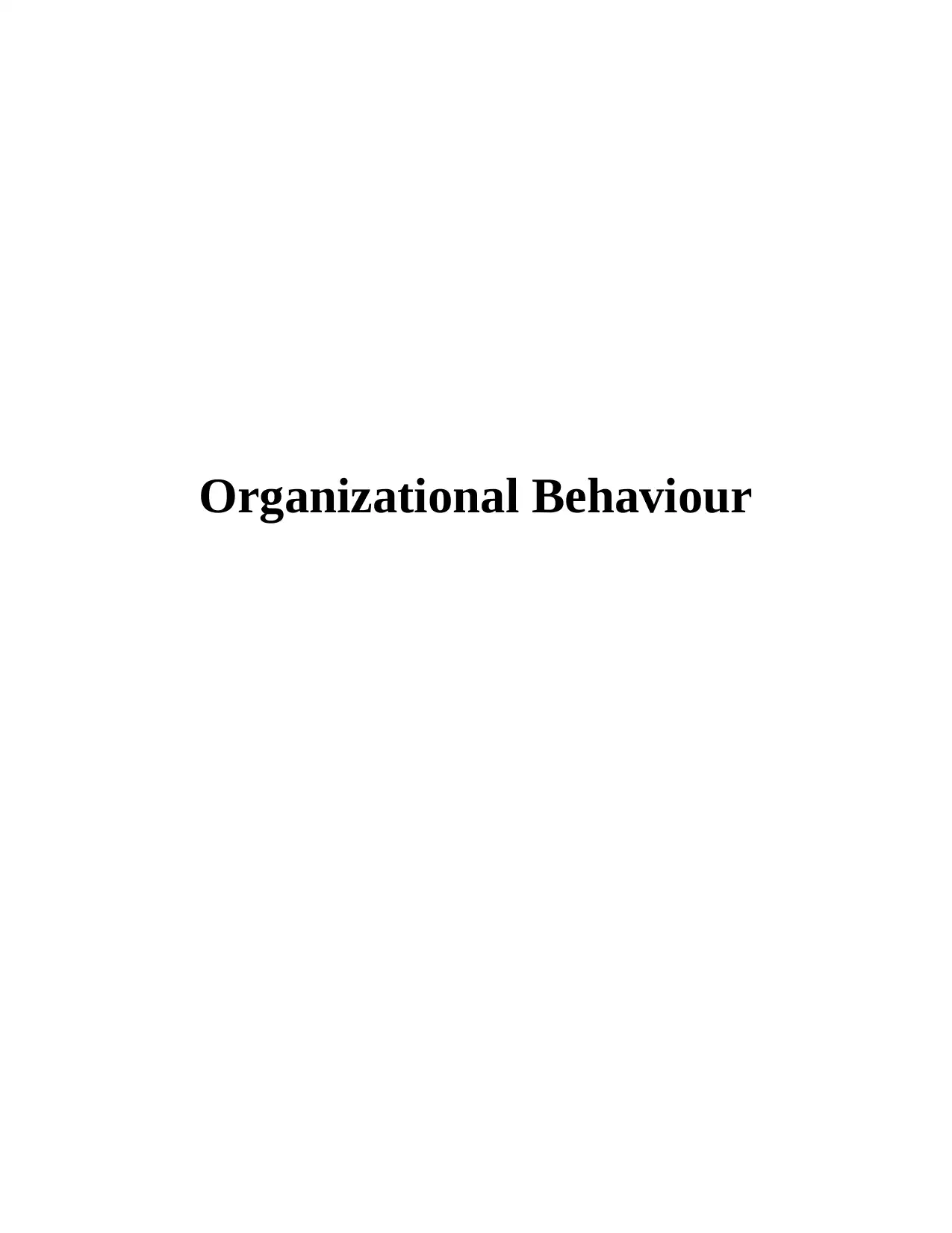
Organizational Behaviour
Paraphrase This Document
Need a fresh take? Get an instant paraphrase of this document with our AI Paraphraser
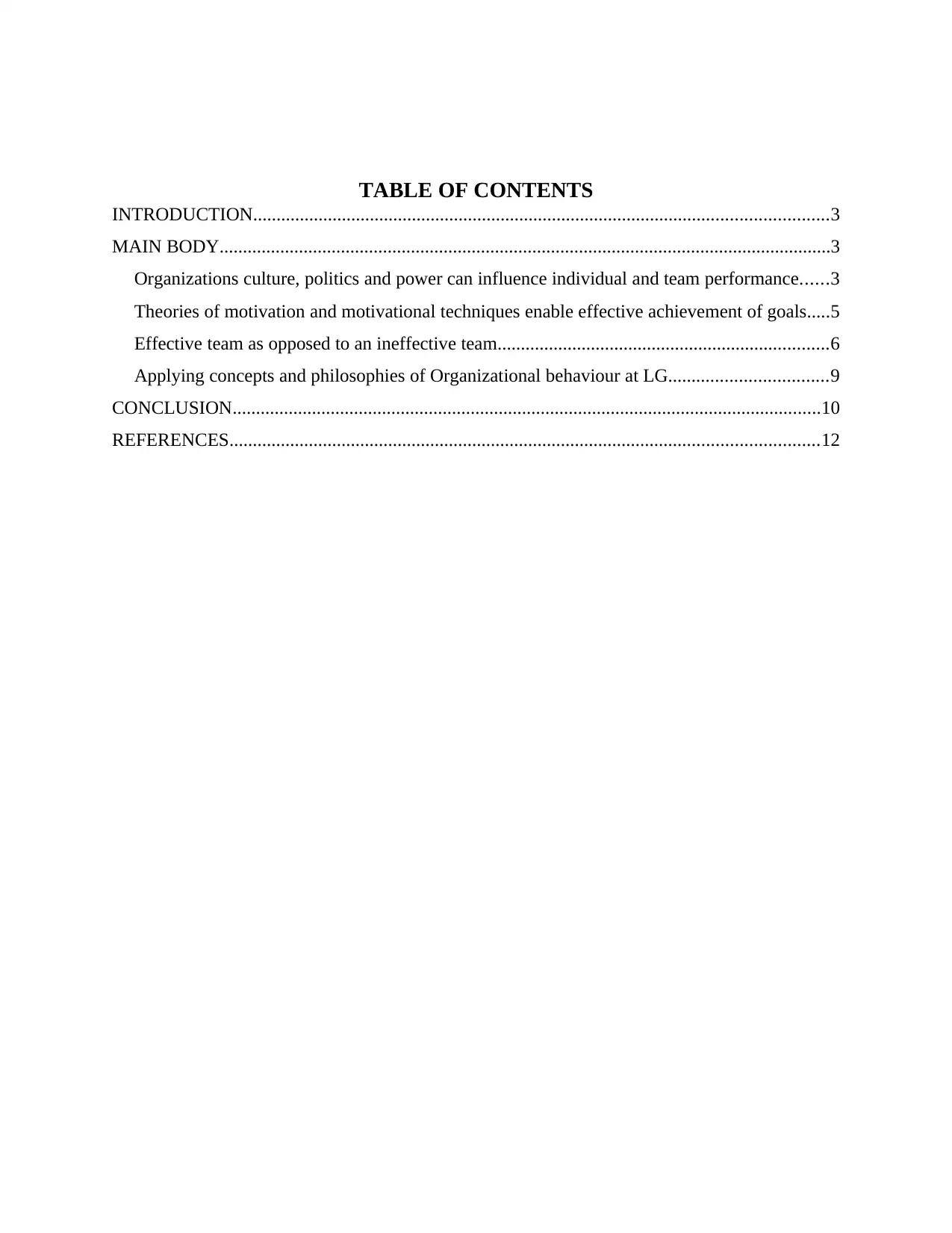
TABLE OF CONTENTS
INTRODUCTION...........................................................................................................................3
MAIN BODY...................................................................................................................................3
Organizations culture, politics and power can influence individual and team performance......3
Theories of motivation and motivational techniques enable effective achievement of goals.....5
Effective team as opposed to an ineffective team.......................................................................6
Applying concepts and philosophies of Organizational behaviour at LG..................................9
CONCLUSION..............................................................................................................................10
REFERENCES..............................................................................................................................12
INTRODUCTION...........................................................................................................................3
MAIN BODY...................................................................................................................................3
Organizations culture, politics and power can influence individual and team performance......3
Theories of motivation and motivational techniques enable effective achievement of goals.....5
Effective team as opposed to an ineffective team.......................................................................6
Applying concepts and philosophies of Organizational behaviour at LG..................................9
CONCLUSION..............................................................................................................................10
REFERENCES..............................................................................................................................12
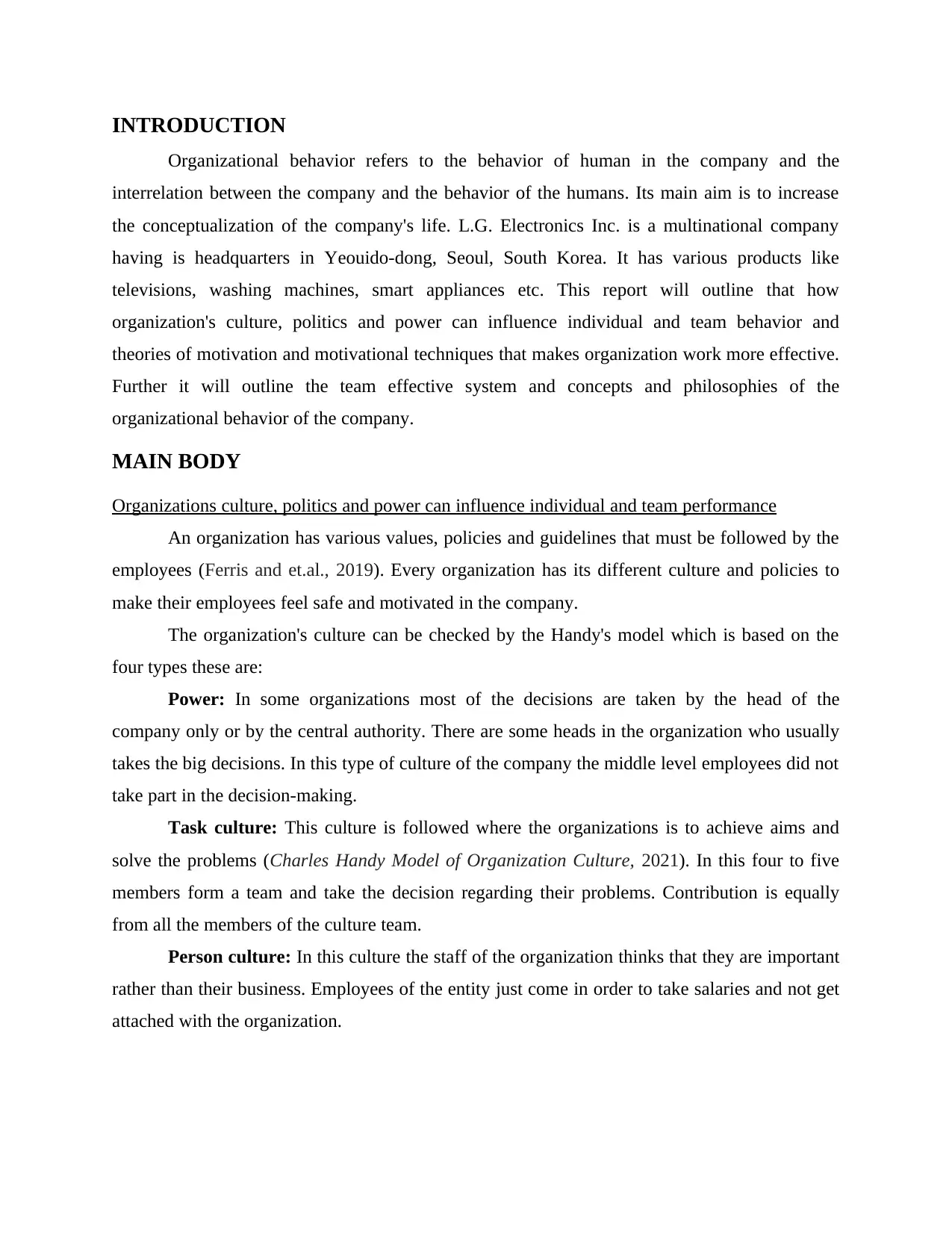
INTRODUCTION
Organizational behavior refers to the behavior of human in the company and the
interrelation between the company and the behavior of the humans. Its main aim is to increase
the conceptualization of the company's life. L.G. Electronics Inc. is a multinational company
having is headquarters in Yeouido-dong, Seoul, South Korea. It has various products like
televisions, washing machines, smart appliances etc. This report will outline that how
organization's culture, politics and power can influence individual and team behavior and
theories of motivation and motivational techniques that makes organization work more effective.
Further it will outline the team effective system and concepts and philosophies of the
organizational behavior of the company.
MAIN BODY
Organizations culture, politics and power can influence individual and team performance
An organization has various values, policies and guidelines that must be followed by the
employees (Ferris and et.al., 2019). Every organization has its different culture and policies to
make their employees feel safe and motivated in the company.
The organization's culture can be checked by the Handy's model which is based on the
four types these are:
Power: In some organizations most of the decisions are taken by the head of the
company only or by the central authority. There are some heads in the organization who usually
takes the big decisions. In this type of culture of the company the middle level employees did not
take part in the decision-making.
Task culture: This culture is followed where the organizations is to achieve aims and
solve the problems (Charles Handy Model of Organization Culture, 2021). In this four to five
members form a team and take the decision regarding their problems. Contribution is equally
from all the members of the culture team.
Person culture: In this culture the staff of the organization thinks that they are important
rather than their business. Employees of the entity just come in order to take salaries and not get
attached with the organization.
Organizational behavior refers to the behavior of human in the company and the
interrelation between the company and the behavior of the humans. Its main aim is to increase
the conceptualization of the company's life. L.G. Electronics Inc. is a multinational company
having is headquarters in Yeouido-dong, Seoul, South Korea. It has various products like
televisions, washing machines, smart appliances etc. This report will outline that how
organization's culture, politics and power can influence individual and team behavior and
theories of motivation and motivational techniques that makes organization work more effective.
Further it will outline the team effective system and concepts and philosophies of the
organizational behavior of the company.
MAIN BODY
Organizations culture, politics and power can influence individual and team performance
An organization has various values, policies and guidelines that must be followed by the
employees (Ferris and et.al., 2019). Every organization has its different culture and policies to
make their employees feel safe and motivated in the company.
The organization's culture can be checked by the Handy's model which is based on the
four types these are:
Power: In some organizations most of the decisions are taken by the head of the
company only or by the central authority. There are some heads in the organization who usually
takes the big decisions. In this type of culture of the company the middle level employees did not
take part in the decision-making.
Task culture: This culture is followed where the organizations is to achieve aims and
solve the problems (Charles Handy Model of Organization Culture, 2021). In this four to five
members form a team and take the decision regarding their problems. Contribution is equally
from all the members of the culture team.
Person culture: In this culture the staff of the organization thinks that they are important
rather than their business. Employees of the entity just come in order to take salaries and not get
attached with the organization.
⊘ This is a preview!⊘
Do you want full access?
Subscribe today to unlock all pages.

Trusted by 1+ million students worldwide
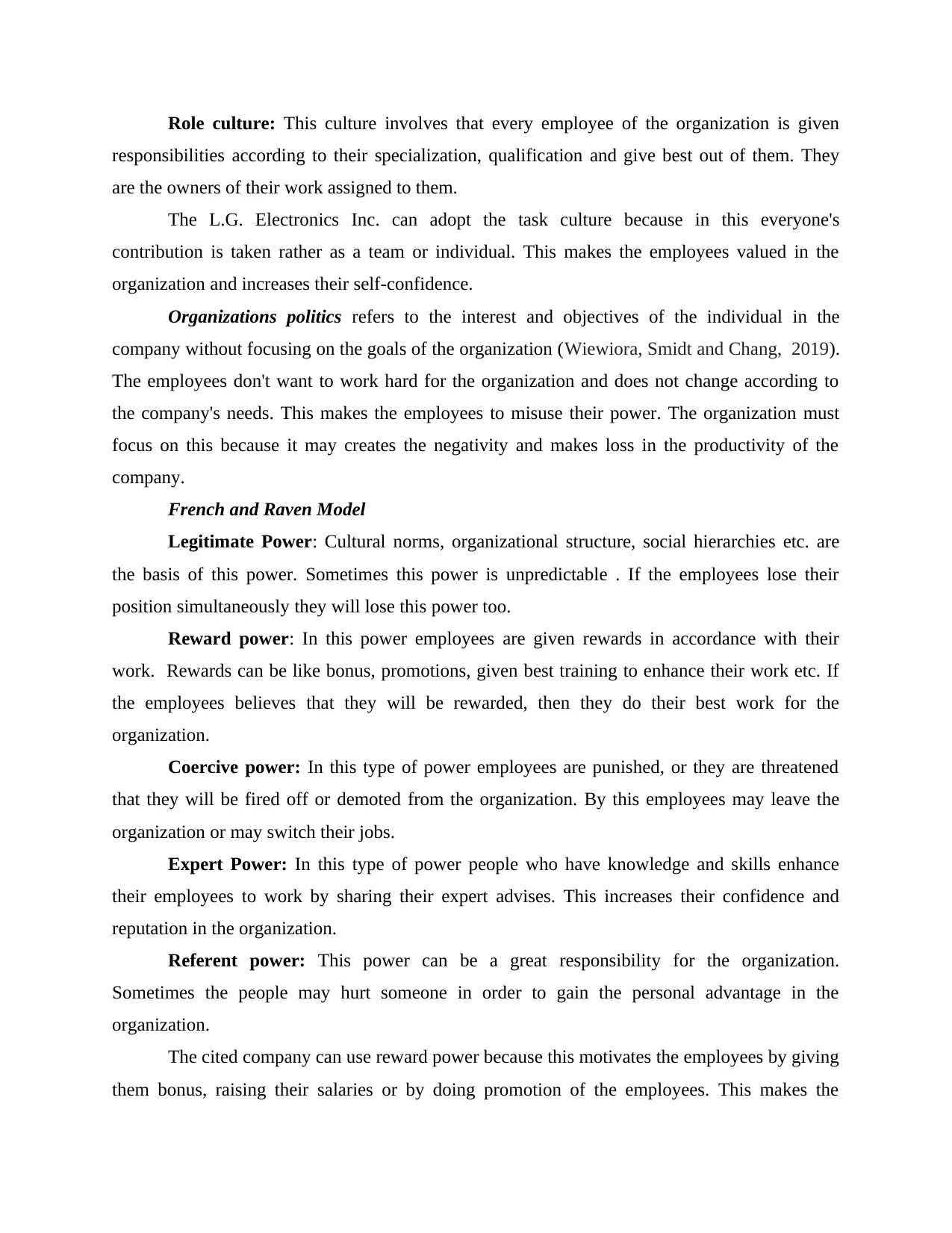
Role culture: This culture involves that every employee of the organization is given
responsibilities according to their specialization, qualification and give best out of them. They
are the owners of their work assigned to them.
The L.G. Electronics Inc. can adopt the task culture because in this everyone's
contribution is taken rather as a team or individual. This makes the employees valued in the
organization and increases their self-confidence.
Organizations politics refers to the interest and objectives of the individual in the
company without focusing on the goals of the organization (Wiewiora, Smidt and Chang, 2019).
The employees don't want to work hard for the organization and does not change according to
the company's needs. This makes the employees to misuse their power. The organization must
focus on this because it may creates the negativity and makes loss in the productivity of the
company.
French and Raven Model
Legitimate Power: Cultural norms, organizational structure, social hierarchies etc. are
the basis of this power. Sometimes this power is unpredictable . If the employees lose their
position simultaneously they will lose this power too.
Reward power: In this power employees are given rewards in accordance with their
work. Rewards can be like bonus, promotions, given best training to enhance their work etc. If
the employees believes that they will be rewarded, then they do their best work for the
organization.
Coercive power: In this type of power employees are punished, or they are threatened
that they will be fired off or demoted from the organization. By this employees may leave the
organization or may switch their jobs.
Expert Power: In this type of power people who have knowledge and skills enhance
their employees to work by sharing their expert advises. This increases their confidence and
reputation in the organization.
Referent power: This power can be a great responsibility for the organization.
Sometimes the people may hurt someone in order to gain the personal advantage in the
organization.
The cited company can use reward power because this motivates the employees by giving
them bonus, raising their salaries or by doing promotion of the employees. This makes the
responsibilities according to their specialization, qualification and give best out of them. They
are the owners of their work assigned to them.
The L.G. Electronics Inc. can adopt the task culture because in this everyone's
contribution is taken rather as a team or individual. This makes the employees valued in the
organization and increases their self-confidence.
Organizations politics refers to the interest and objectives of the individual in the
company without focusing on the goals of the organization (Wiewiora, Smidt and Chang, 2019).
The employees don't want to work hard for the organization and does not change according to
the company's needs. This makes the employees to misuse their power. The organization must
focus on this because it may creates the negativity and makes loss in the productivity of the
company.
French and Raven Model
Legitimate Power: Cultural norms, organizational structure, social hierarchies etc. are
the basis of this power. Sometimes this power is unpredictable . If the employees lose their
position simultaneously they will lose this power too.
Reward power: In this power employees are given rewards in accordance with their
work. Rewards can be like bonus, promotions, given best training to enhance their work etc. If
the employees believes that they will be rewarded, then they do their best work for the
organization.
Coercive power: In this type of power employees are punished, or they are threatened
that they will be fired off or demoted from the organization. By this employees may leave the
organization or may switch their jobs.
Expert Power: In this type of power people who have knowledge and skills enhance
their employees to work by sharing their expert advises. This increases their confidence and
reputation in the organization.
Referent power: This power can be a great responsibility for the organization.
Sometimes the people may hurt someone in order to gain the personal advantage in the
organization.
The cited company can use reward power because this motivates the employees by giving
them bonus, raising their salaries or by doing promotion of the employees. This makes the
Paraphrase This Document
Need a fresh take? Get an instant paraphrase of this document with our AI Paraphraser
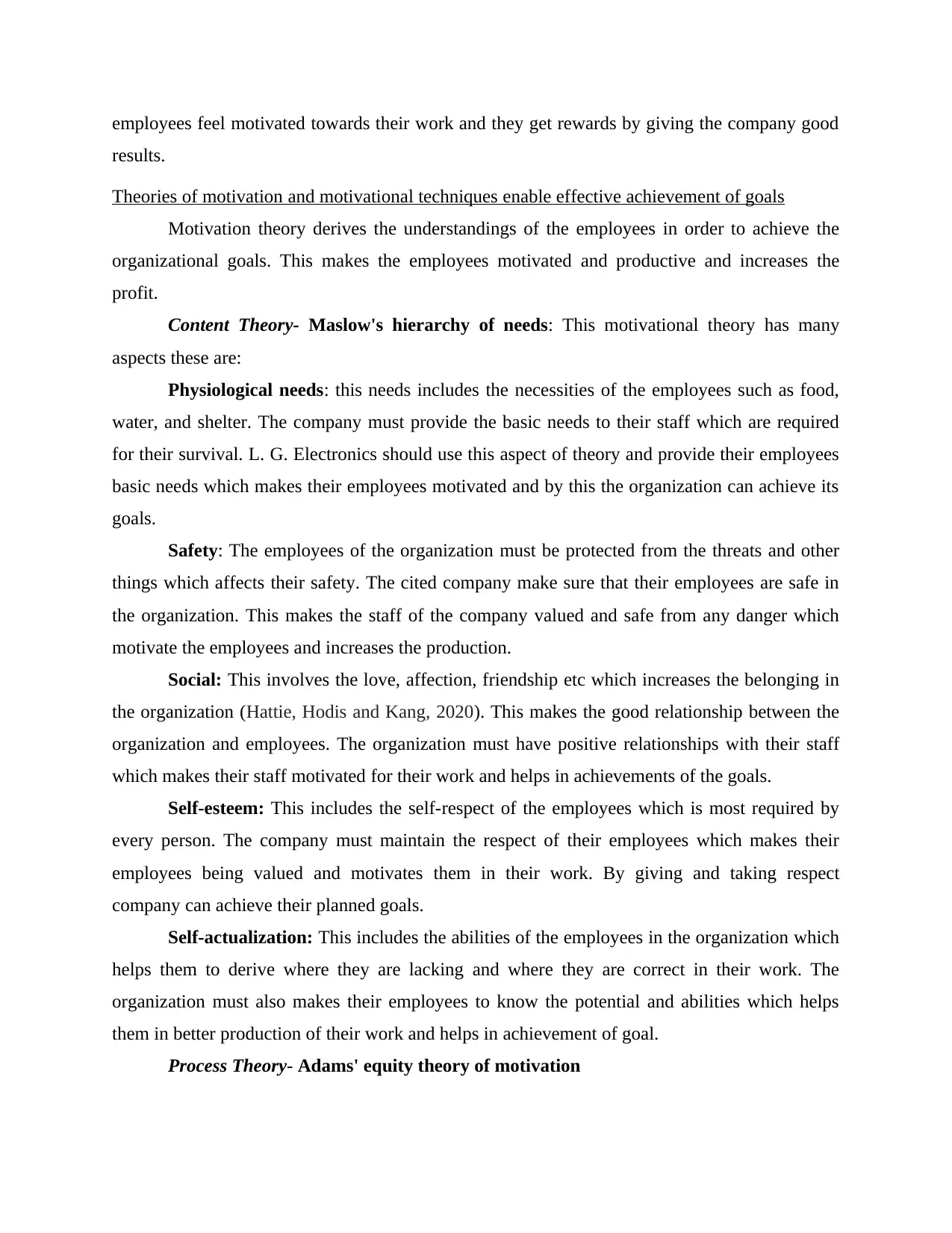
employees feel motivated towards their work and they get rewards by giving the company good
results.
Theories of motivation and motivational techniques enable effective achievement of goals
Motivation theory derives the understandings of the employees in order to achieve the
organizational goals. This makes the employees motivated and productive and increases the
profit.
Content Theory- Maslow's hierarchy of needs: This motivational theory has many
aspects these are:
Physiological needs: this needs includes the necessities of the employees such as food,
water, and shelter. The company must provide the basic needs to their staff which are required
for their survival. L. G. Electronics should use this aspect of theory and provide their employees
basic needs which makes their employees motivated and by this the organization can achieve its
goals.
Safety: The employees of the organization must be protected from the threats and other
things which affects their safety. The cited company make sure that their employees are safe in
the organization. This makes the staff of the company valued and safe from any danger which
motivate the employees and increases the production.
Social: This involves the love, affection, friendship etc which increases the belonging in
the organization (Hattie, Hodis and Kang, 2020). This makes the good relationship between the
organization and employees. The organization must have positive relationships with their staff
which makes their staff motivated for their work and helps in achievements of the goals.
Self-esteem: This includes the self-respect of the employees which is most required by
every person. The company must maintain the respect of their employees which makes their
employees being valued and motivates them in their work. By giving and taking respect
company can achieve their planned goals.
Self-actualization: This includes the abilities of the employees in the organization which
helps them to derive where they are lacking and where they are correct in their work. The
organization must also makes their employees to know the potential and abilities which helps
them in better production of their work and helps in achievement of goal.
Process Theory- Adams' equity theory of motivation
results.
Theories of motivation and motivational techniques enable effective achievement of goals
Motivation theory derives the understandings of the employees in order to achieve the
organizational goals. This makes the employees motivated and productive and increases the
profit.
Content Theory- Maslow's hierarchy of needs: This motivational theory has many
aspects these are:
Physiological needs: this needs includes the necessities of the employees such as food,
water, and shelter. The company must provide the basic needs to their staff which are required
for their survival. L. G. Electronics should use this aspect of theory and provide their employees
basic needs which makes their employees motivated and by this the organization can achieve its
goals.
Safety: The employees of the organization must be protected from the threats and other
things which affects their safety. The cited company make sure that their employees are safe in
the organization. This makes the staff of the company valued and safe from any danger which
motivate the employees and increases the production.
Social: This involves the love, affection, friendship etc which increases the belonging in
the organization (Hattie, Hodis and Kang, 2020). This makes the good relationship between the
organization and employees. The organization must have positive relationships with their staff
which makes their staff motivated for their work and helps in achievements of the goals.
Self-esteem: This includes the self-respect of the employees which is most required by
every person. The company must maintain the respect of their employees which makes their
employees being valued and motivates them in their work. By giving and taking respect
company can achieve their planned goals.
Self-actualization: This includes the abilities of the employees in the organization which
helps them to derive where they are lacking and where they are correct in their work. The
organization must also makes their employees to know the potential and abilities which helps
them in better production of their work and helps in achievement of goal.
Process Theory- Adams' equity theory of motivation
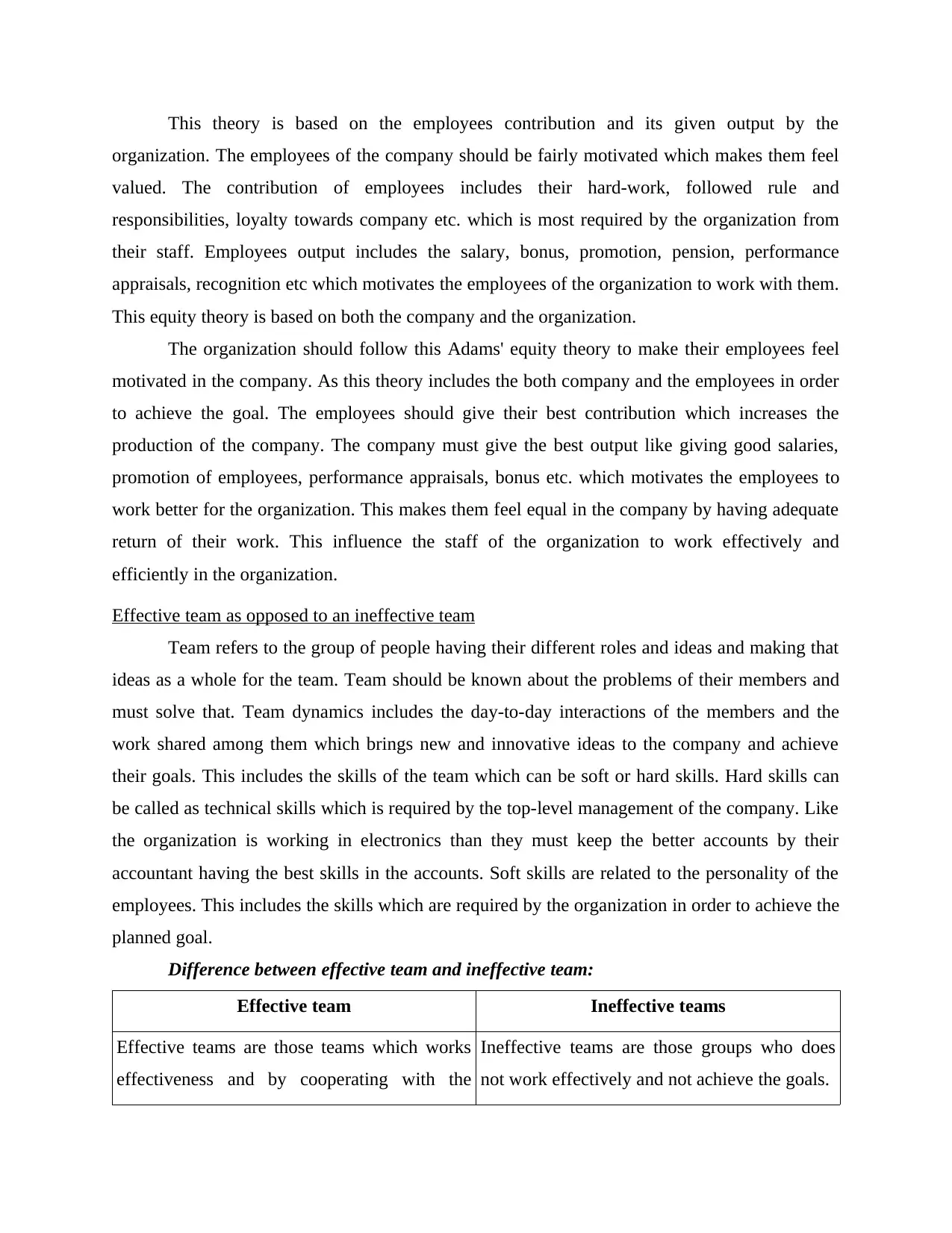
This theory is based on the employees contribution and its given output by the
organization. The employees of the company should be fairly motivated which makes them feel
valued. The contribution of employees includes their hard-work, followed rule and
responsibilities, loyalty towards company etc. which is most required by the organization from
their staff. Employees output includes the salary, bonus, promotion, pension, performance
appraisals, recognition etc which motivates the employees of the organization to work with them.
This equity theory is based on both the company and the organization.
The organization should follow this Adams' equity theory to make their employees feel
motivated in the company. As this theory includes the both company and the employees in order
to achieve the goal. The employees should give their best contribution which increases the
production of the company. The company must give the best output like giving good salaries,
promotion of employees, performance appraisals, bonus etc. which motivates the employees to
work better for the organization. This makes them feel equal in the company by having adequate
return of their work. This influence the staff of the organization to work effectively and
efficiently in the organization.
Effective team as opposed to an ineffective team
Team refers to the group of people having their different roles and ideas and making that
ideas as a whole for the team. Team should be known about the problems of their members and
must solve that. Team dynamics includes the day-to-day interactions of the members and the
work shared among them which brings new and innovative ideas to the company and achieve
their goals. This includes the skills of the team which can be soft or hard skills. Hard skills can
be called as technical skills which is required by the top-level management of the company. Like
the organization is working in electronics than they must keep the better accounts by their
accountant having the best skills in the accounts. Soft skills are related to the personality of the
employees. This includes the skills which are required by the organization in order to achieve the
planned goal.
Difference between effective team and ineffective team:
Effective team Ineffective teams
Effective teams are those teams which works
effectiveness and by cooperating with the
Ineffective teams are those groups who does
not work effectively and not achieve the goals.
organization. The employees of the company should be fairly motivated which makes them feel
valued. The contribution of employees includes their hard-work, followed rule and
responsibilities, loyalty towards company etc. which is most required by the organization from
their staff. Employees output includes the salary, bonus, promotion, pension, performance
appraisals, recognition etc which motivates the employees of the organization to work with them.
This equity theory is based on both the company and the organization.
The organization should follow this Adams' equity theory to make their employees feel
motivated in the company. As this theory includes the both company and the employees in order
to achieve the goal. The employees should give their best contribution which increases the
production of the company. The company must give the best output like giving good salaries,
promotion of employees, performance appraisals, bonus etc. which motivates the employees to
work better for the organization. This makes them feel equal in the company by having adequate
return of their work. This influence the staff of the organization to work effectively and
efficiently in the organization.
Effective team as opposed to an ineffective team
Team refers to the group of people having their different roles and ideas and making that
ideas as a whole for the team. Team should be known about the problems of their members and
must solve that. Team dynamics includes the day-to-day interactions of the members and the
work shared among them which brings new and innovative ideas to the company and achieve
their goals. This includes the skills of the team which can be soft or hard skills. Hard skills can
be called as technical skills which is required by the top-level management of the company. Like
the organization is working in electronics than they must keep the better accounts by their
accountant having the best skills in the accounts. Soft skills are related to the personality of the
employees. This includes the skills which are required by the organization in order to achieve the
planned goal.
Difference between effective team and ineffective team:
Effective team Ineffective teams
Effective teams are those teams which works
effectiveness and by cooperating with the
Ineffective teams are those groups who does
not work effectively and not achieve the goals.
⊘ This is a preview!⊘
Do you want full access?
Subscribe today to unlock all pages.

Trusted by 1+ million students worldwide
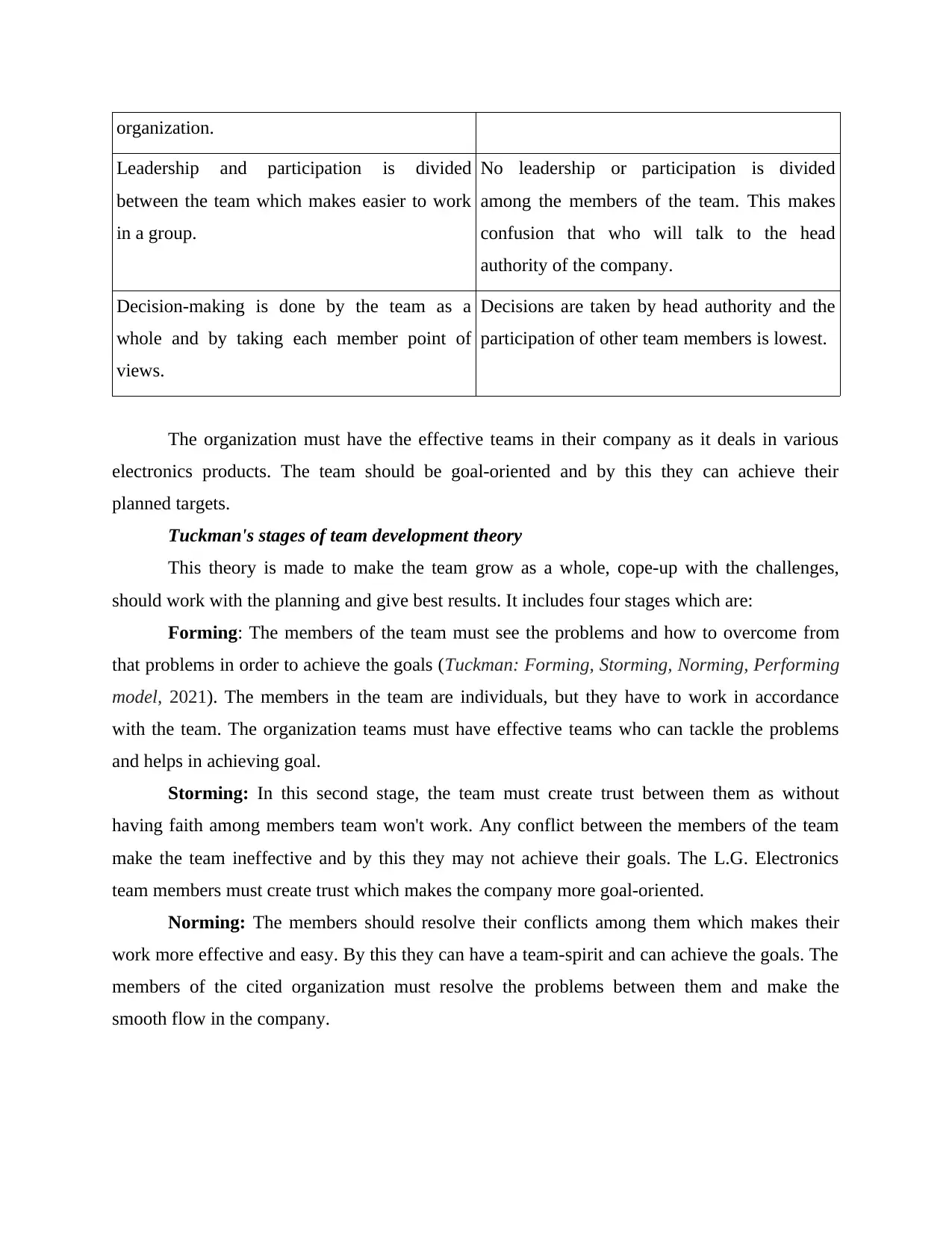
organization.
Leadership and participation is divided
between the team which makes easier to work
in a group.
No leadership or participation is divided
among the members of the team. This makes
confusion that who will talk to the head
authority of the company.
Decision-making is done by the team as a
whole and by taking each member point of
views.
Decisions are taken by head authority and the
participation of other team members is lowest.
The organization must have the effective teams in their company as it deals in various
electronics products. The team should be goal-oriented and by this they can achieve their
planned targets.
Tuckman's stages of team development theory
This theory is made to make the team grow as a whole, cope-up with the challenges,
should work with the planning and give best results. It includes four stages which are:
Forming: The members of the team must see the problems and how to overcome from
that problems in order to achieve the goals (Tuckman: Forming, Storming, Norming, Performing
model, 2021). The members in the team are individuals, but they have to work in accordance
with the team. The organization teams must have effective teams who can tackle the problems
and helps in achieving goal.
Storming: In this second stage, the team must create trust between them as without
having faith among members team won't work. Any conflict between the members of the team
make the team ineffective and by this they may not achieve their goals. The L.G. Electronics
team members must create trust which makes the company more goal-oriented.
Norming: The members should resolve their conflicts among them which makes their
work more effective and easy. By this they can have a team-spirit and can achieve the goals. The
members of the cited organization must resolve the problems between them and make the
smooth flow in the company.
Leadership and participation is divided
between the team which makes easier to work
in a group.
No leadership or participation is divided
among the members of the team. This makes
confusion that who will talk to the head
authority of the company.
Decision-making is done by the team as a
whole and by taking each member point of
views.
Decisions are taken by head authority and the
participation of other team members is lowest.
The organization must have the effective teams in their company as it deals in various
electronics products. The team should be goal-oriented and by this they can achieve their
planned targets.
Tuckman's stages of team development theory
This theory is made to make the team grow as a whole, cope-up with the challenges,
should work with the planning and give best results. It includes four stages which are:
Forming: The members of the team must see the problems and how to overcome from
that problems in order to achieve the goals (Tuckman: Forming, Storming, Norming, Performing
model, 2021). The members in the team are individuals, but they have to work in accordance
with the team. The organization teams must have effective teams who can tackle the problems
and helps in achieving goal.
Storming: In this second stage, the team must create trust between them as without
having faith among members team won't work. Any conflict between the members of the team
make the team ineffective and by this they may not achieve their goals. The L.G. Electronics
team members must create trust which makes the company more goal-oriented.
Norming: The members should resolve their conflicts among them which makes their
work more effective and easy. By this they can have a team-spirit and can achieve the goals. The
members of the cited organization must resolve the problems between them and make the
smooth flow in the company.
Paraphrase This Document
Need a fresh take? Get an instant paraphrase of this document with our AI Paraphraser
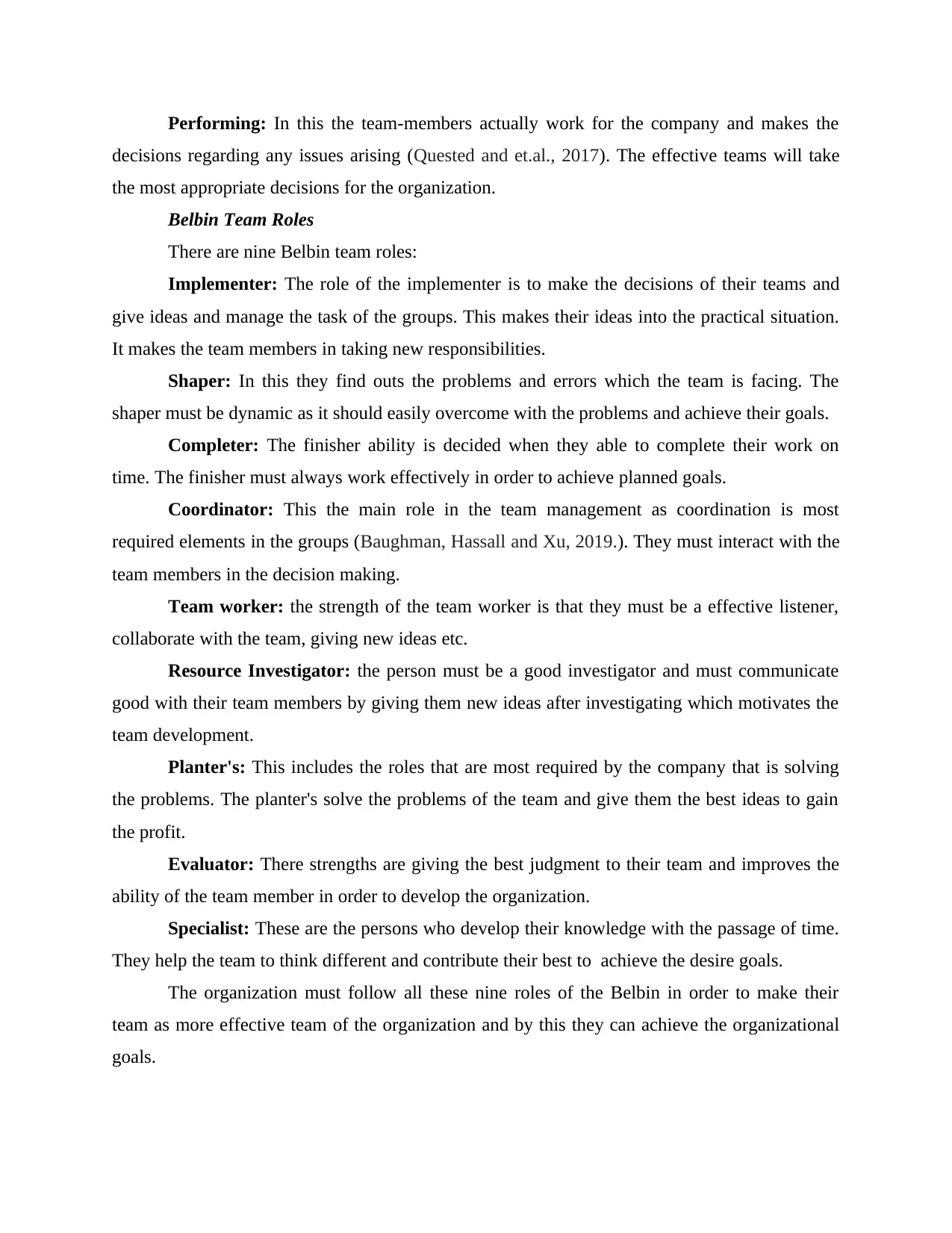
Performing: In this the team-members actually work for the company and makes the
decisions regarding any issues arising (Quested and et.al., 2017). The effective teams will take
the most appropriate decisions for the organization.
Belbin Team Roles
There are nine Belbin team roles:
Implementer: The role of the implementer is to make the decisions of their teams and
give ideas and manage the task of the groups. This makes their ideas into the practical situation.
It makes the team members in taking new responsibilities.
Shaper: In this they find outs the problems and errors which the team is facing. The
shaper must be dynamic as it should easily overcome with the problems and achieve their goals.
Completer: The finisher ability is decided when they able to complete their work on
time. The finisher must always work effectively in order to achieve planned goals.
Coordinator: This the main role in the team management as coordination is most
required elements in the groups (Baughman, Hassall and Xu, 2019.). They must interact with the
team members in the decision making.
Team worker: the strength of the team worker is that they must be a effective listener,
collaborate with the team, giving new ideas etc.
Resource Investigator: the person must be a good investigator and must communicate
good with their team members by giving them new ideas after investigating which motivates the
team development.
Planter's: This includes the roles that are most required by the company that is solving
the problems. The planter's solve the problems of the team and give them the best ideas to gain
the profit.
Evaluator: There strengths are giving the best judgment to their team and improves the
ability of the team member in order to develop the organization.
Specialist: These are the persons who develop their knowledge with the passage of time.
They help the team to think different and contribute their best to achieve the desire goals.
The organization must follow all these nine roles of the Belbin in order to make their
team as more effective team of the organization and by this they can achieve the organizational
goals.
decisions regarding any issues arising (Quested and et.al., 2017). The effective teams will take
the most appropriate decisions for the organization.
Belbin Team Roles
There are nine Belbin team roles:
Implementer: The role of the implementer is to make the decisions of their teams and
give ideas and manage the task of the groups. This makes their ideas into the practical situation.
It makes the team members in taking new responsibilities.
Shaper: In this they find outs the problems and errors which the team is facing. The
shaper must be dynamic as it should easily overcome with the problems and achieve their goals.
Completer: The finisher ability is decided when they able to complete their work on
time. The finisher must always work effectively in order to achieve planned goals.
Coordinator: This the main role in the team management as coordination is most
required elements in the groups (Baughman, Hassall and Xu, 2019.). They must interact with the
team members in the decision making.
Team worker: the strength of the team worker is that they must be a effective listener,
collaborate with the team, giving new ideas etc.
Resource Investigator: the person must be a good investigator and must communicate
good with their team members by giving them new ideas after investigating which motivates the
team development.
Planter's: This includes the roles that are most required by the company that is solving
the problems. The planter's solve the problems of the team and give them the best ideas to gain
the profit.
Evaluator: There strengths are giving the best judgment to their team and improves the
ability of the team member in order to develop the organization.
Specialist: These are the persons who develop their knowledge with the passage of time.
They help the team to think different and contribute their best to achieve the desire goals.
The organization must follow all these nine roles of the Belbin in order to make their
team as more effective team of the organization and by this they can achieve the organizational
goals.
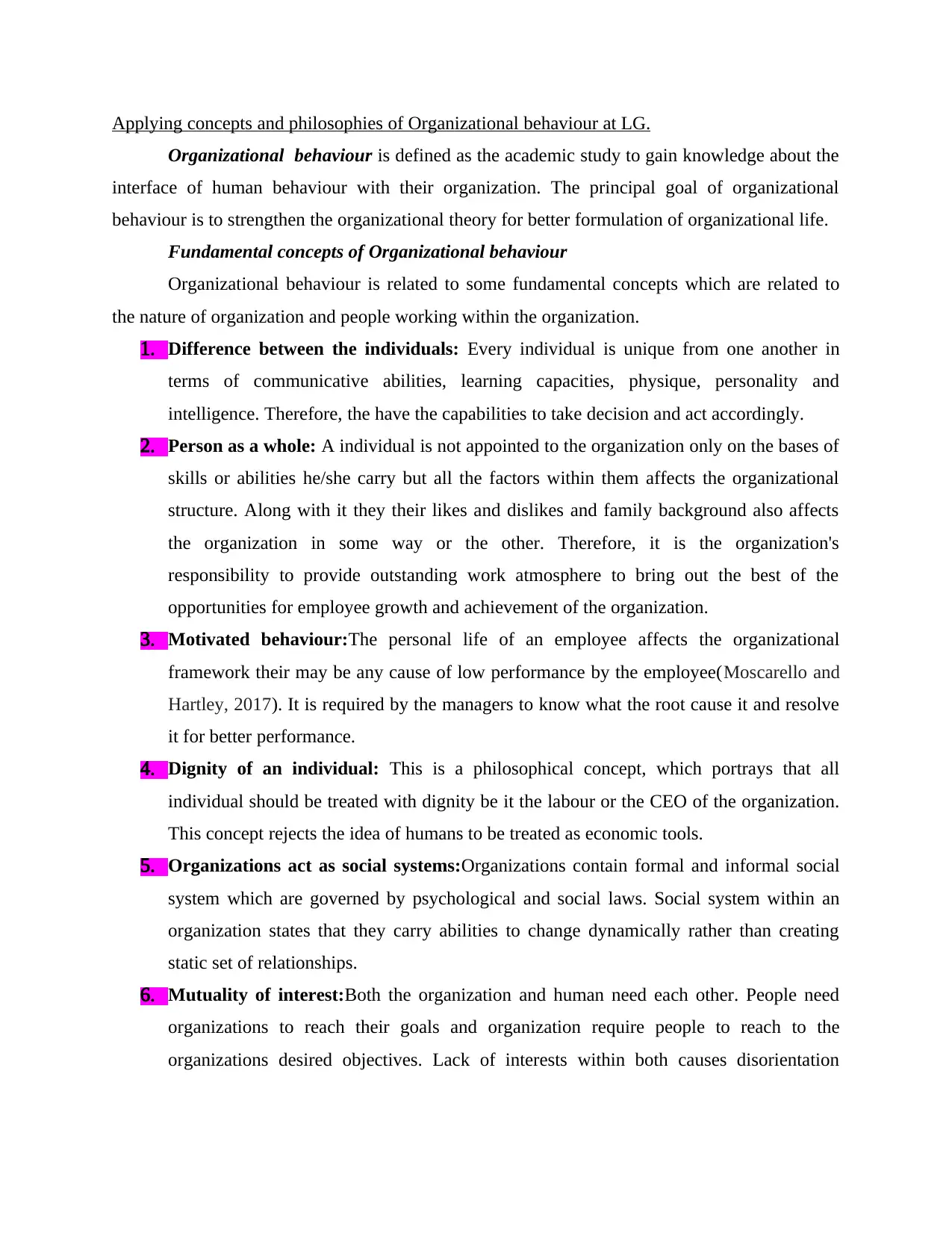
Applying concepts and philosophies of Organizational behaviour at LG.
Organizational behaviour is defined as the academic study to gain knowledge about the
interface of human behaviour with their organization. The principal goal of organizational
behaviour is to strengthen the organizational theory for better formulation of organizational life.
Fundamental concepts of Organizational behaviour
Organizational behaviour is related to some fundamental concepts which are related to
the nature of organization and people working within the organization.
1. Difference between the individuals: Every individual is unique from one another in
terms of communicative abilities, learning capacities, physique, personality and
intelligence. Therefore, the have the capabilities to take decision and act accordingly.
2. Person as a whole: A individual is not appointed to the organization only on the bases of
skills or abilities he/she carry but all the factors within them affects the organizational
structure. Along with it they their likes and dislikes and family background also affects
the organization in some way or the other. Therefore, it is the organization's
responsibility to provide outstanding work atmosphere to bring out the best of the
opportunities for employee growth and achievement of the organization.
3. Motivated behaviour:The personal life of an employee affects the organizational
framework their may be any cause of low performance by the employee(Moscarello and
Hartley, 2017). It is required by the managers to know what the root cause it and resolve
it for better performance.
4. Dignity of an individual: This is a philosophical concept, which portrays that all
individual should be treated with dignity be it the labour or the CEO of the organization.
This concept rejects the idea of humans to be treated as economic tools.
5. Organizations act as social systems:Organizations contain formal and informal social
system which are governed by psychological and social laws. Social system within an
organization states that they carry abilities to change dynamically rather than creating
static set of relationships.
6. Mutuality of interest:Both the organization and human need each other. People need
organizations to reach their goals and organization require people to reach to the
organizations desired objectives. Lack of interests within both causes disorientation
Organizational behaviour is defined as the academic study to gain knowledge about the
interface of human behaviour with their organization. The principal goal of organizational
behaviour is to strengthen the organizational theory for better formulation of organizational life.
Fundamental concepts of Organizational behaviour
Organizational behaviour is related to some fundamental concepts which are related to
the nature of organization and people working within the organization.
1. Difference between the individuals: Every individual is unique from one another in
terms of communicative abilities, learning capacities, physique, personality and
intelligence. Therefore, the have the capabilities to take decision and act accordingly.
2. Person as a whole: A individual is not appointed to the organization only on the bases of
skills or abilities he/she carry but all the factors within them affects the organizational
structure. Along with it they their likes and dislikes and family background also affects
the organization in some way or the other. Therefore, it is the organization's
responsibility to provide outstanding work atmosphere to bring out the best of the
opportunities for employee growth and achievement of the organization.
3. Motivated behaviour:The personal life of an employee affects the organizational
framework their may be any cause of low performance by the employee(Moscarello and
Hartley, 2017). It is required by the managers to know what the root cause it and resolve
it for better performance.
4. Dignity of an individual: This is a philosophical concept, which portrays that all
individual should be treated with dignity be it the labour or the CEO of the organization.
This concept rejects the idea of humans to be treated as economic tools.
5. Organizations act as social systems:Organizations contain formal and informal social
system which are governed by psychological and social laws. Social system within an
organization states that they carry abilities to change dynamically rather than creating
static set of relationships.
6. Mutuality of interest:Both the organization and human need each other. People need
organizations to reach their goals and organization require people to reach to the
organizations desired objectives. Lack of interests within both causes disorientation
⊘ This is a preview!⊘
Do you want full access?
Subscribe today to unlock all pages.

Trusted by 1+ million students worldwide
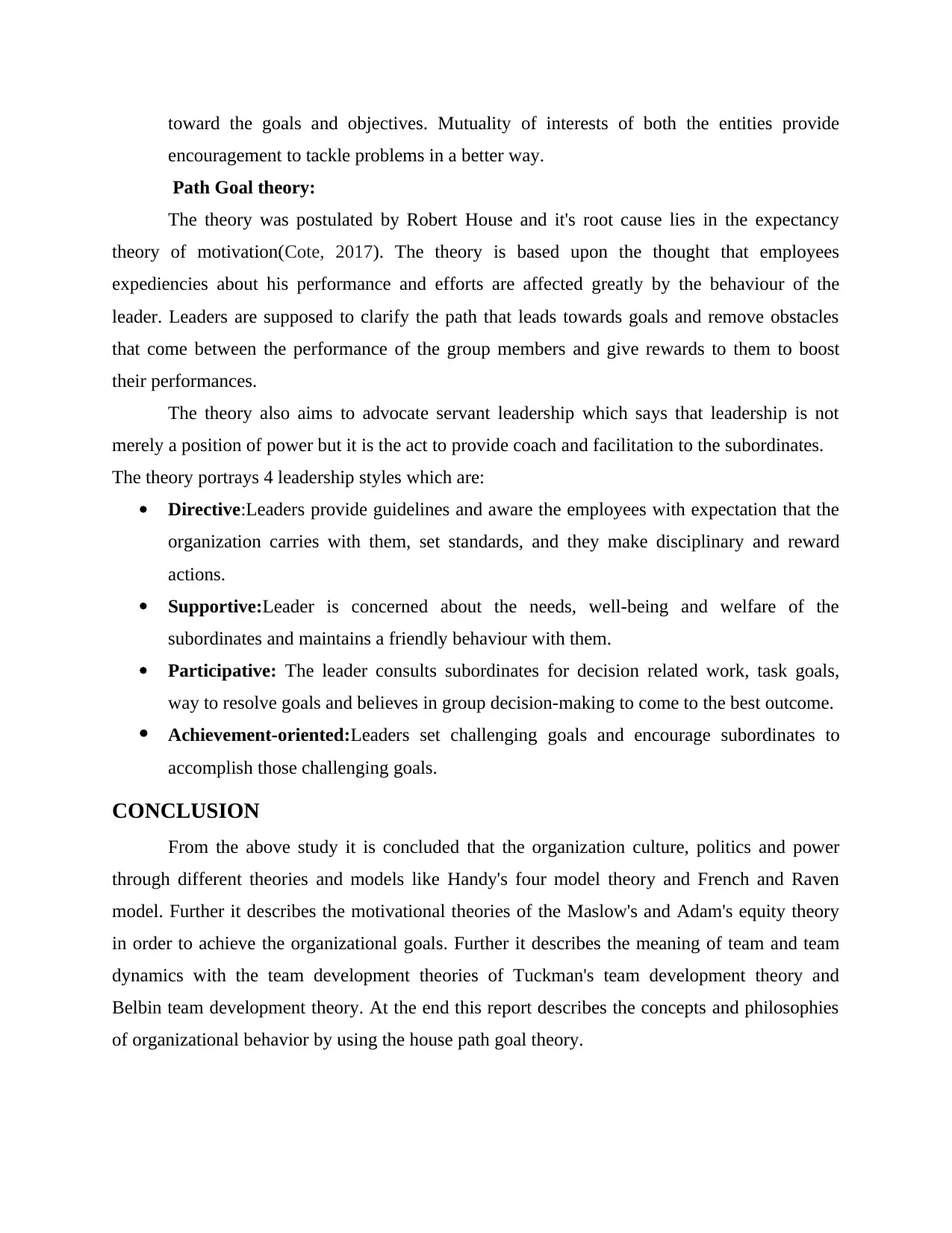
toward the goals and objectives. Mutuality of interests of both the entities provide
encouragement to tackle problems in a better way.
Path Goal theory:
The theory was postulated by Robert House and it's root cause lies in the expectancy
theory of motivation(Cote, 2017). The theory is based upon the thought that employees
expediencies about his performance and efforts are affected greatly by the behaviour of the
leader. Leaders are supposed to clarify the path that leads towards goals and remove obstacles
that come between the performance of the group members and give rewards to them to boost
their performances.
The theory also aims to advocate servant leadership which says that leadership is not
merely a position of power but it is the act to provide coach and facilitation to the subordinates.
The theory portrays 4 leadership styles which are:
Directive:Leaders provide guidelines and aware the employees with expectation that the
organization carries with them, set standards, and they make disciplinary and reward
actions.
Supportive:Leader is concerned about the needs, well-being and welfare of the
subordinates and maintains a friendly behaviour with them.
Participative: The leader consults subordinates for decision related work, task goals,
way to resolve goals and believes in group decision-making to come to the best outcome.
Achievement-oriented:Leaders set challenging goals and encourage subordinates to
accomplish those challenging goals.
CONCLUSION
From the above study it is concluded that the organization culture, politics and power
through different theories and models like Handy's four model theory and French and Raven
model. Further it describes the motivational theories of the Maslow's and Adam's equity theory
in order to achieve the organizational goals. Further it describes the meaning of team and team
dynamics with the team development theories of Tuckman's team development theory and
Belbin team development theory. At the end this report describes the concepts and philosophies
of organizational behavior by using the house path goal theory.
encouragement to tackle problems in a better way.
Path Goal theory:
The theory was postulated by Robert House and it's root cause lies in the expectancy
theory of motivation(Cote, 2017). The theory is based upon the thought that employees
expediencies about his performance and efforts are affected greatly by the behaviour of the
leader. Leaders are supposed to clarify the path that leads towards goals and remove obstacles
that come between the performance of the group members and give rewards to them to boost
their performances.
The theory also aims to advocate servant leadership which says that leadership is not
merely a position of power but it is the act to provide coach and facilitation to the subordinates.
The theory portrays 4 leadership styles which are:
Directive:Leaders provide guidelines and aware the employees with expectation that the
organization carries with them, set standards, and they make disciplinary and reward
actions.
Supportive:Leader is concerned about the needs, well-being and welfare of the
subordinates and maintains a friendly behaviour with them.
Participative: The leader consults subordinates for decision related work, task goals,
way to resolve goals and believes in group decision-making to come to the best outcome.
Achievement-oriented:Leaders set challenging goals and encourage subordinates to
accomplish those challenging goals.
CONCLUSION
From the above study it is concluded that the organization culture, politics and power
through different theories and models like Handy's four model theory and French and Raven
model. Further it describes the motivational theories of the Maslow's and Adam's equity theory
in order to achieve the organizational goals. Further it describes the meaning of team and team
dynamics with the team development theories of Tuckman's team development theory and
Belbin team development theory. At the end this report describes the concepts and philosophies
of organizational behavior by using the house path goal theory.
Paraphrase This Document
Need a fresh take? Get an instant paraphrase of this document with our AI Paraphraser
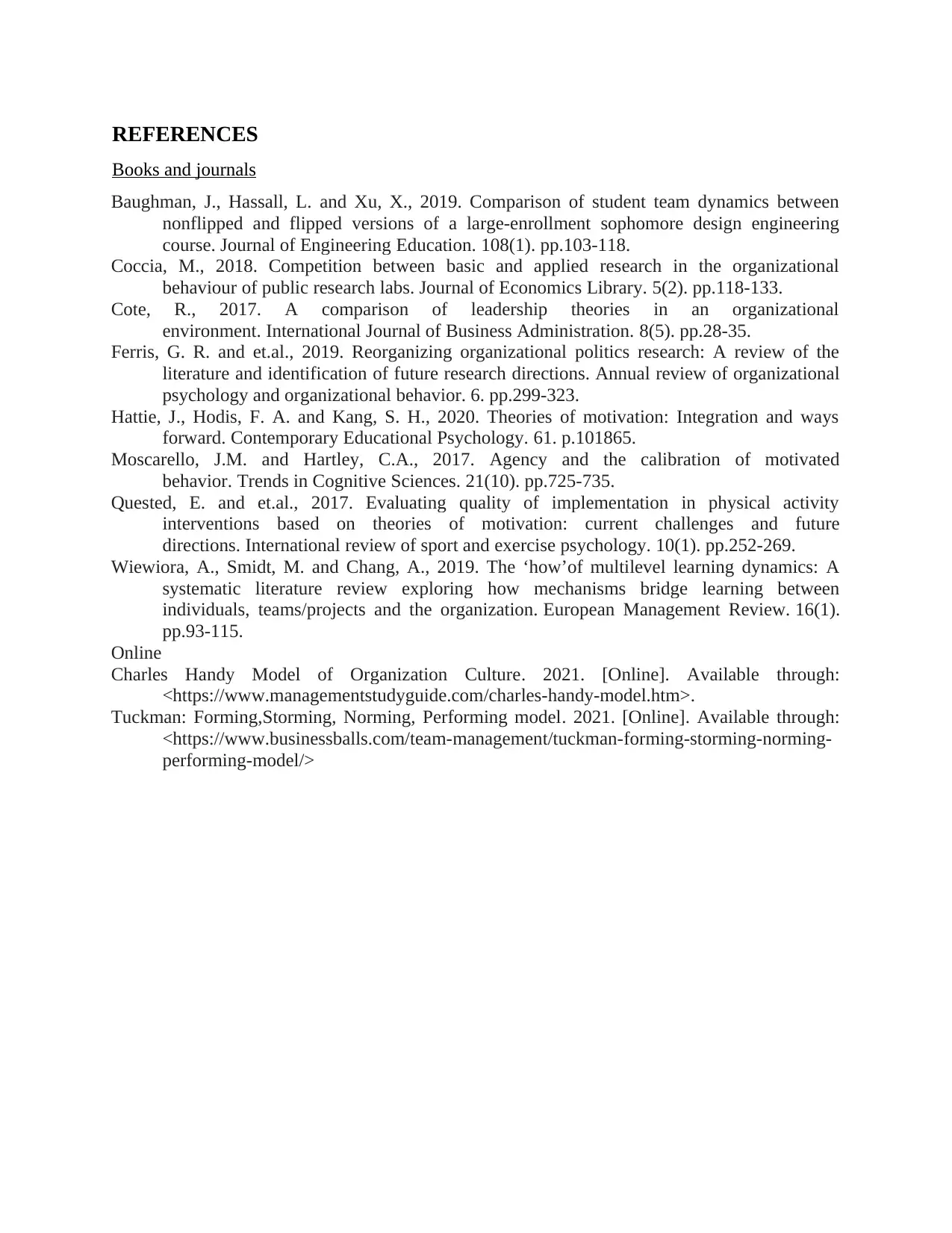
REFERENCES
Books and journals
Baughman, J., Hassall, L. and Xu, X., 2019. Comparison of student team dynamics between
nonflipped and flipped versions of a large‐enrollment sophomore design engineering
course. Journal of Engineering Education. 108(1). pp.103-118.
Coccia, M., 2018. Competition between basic and applied research in the organizational
behaviour of public research labs. Journal of Economics Library. 5(2). pp.118-133.
Cote, R., 2017. A comparison of leadership theories in an organizational
environment. International Journal of Business Administration. 8(5). pp.28-35.
Ferris, G. R. and et.al., 2019. Reorganizing organizational politics research: A review of the
literature and identification of future research directions. Annual review of organizational
psychology and organizational behavior. 6. pp.299-323.
Hattie, J., Hodis, F. A. and Kang, S. H., 2020. Theories of motivation: Integration and ways
forward. Contemporary Educational Psychology. 61. p.101865.
Moscarello, J.M. and Hartley, C.A., 2017. Agency and the calibration of motivated
behavior. Trends in Cognitive Sciences. 21(10). pp.725-735.
Quested, E. and et.al., 2017. Evaluating quality of implementation in physical activity
interventions based on theories of motivation: current challenges and future
directions. International review of sport and exercise psychology. 10(1). pp.252-269.
Wiewiora, A., Smidt, M. and Chang, A., 2019. The ‘how’of multilevel learning dynamics: A
systematic literature review exploring how mechanisms bridge learning between
individuals, teams/projects and the organization. European Management Review. 16(1).
pp.93-115.
Online
Charles Handy Model of Organization Culture. 2021. [Online]. Available through:
<https://www.managementstudyguide.com/charles-handy-model.htm>.
Tuckman: Forming,Storming, Norming, Performing model. 2021. [Online]. Available through:
<https://www.businessballs.com/team-management/tuckman-forming-storming-norming-
performing-model/>
Books and journals
Baughman, J., Hassall, L. and Xu, X., 2019. Comparison of student team dynamics between
nonflipped and flipped versions of a large‐enrollment sophomore design engineering
course. Journal of Engineering Education. 108(1). pp.103-118.
Coccia, M., 2018. Competition between basic and applied research in the organizational
behaviour of public research labs. Journal of Economics Library. 5(2). pp.118-133.
Cote, R., 2017. A comparison of leadership theories in an organizational
environment. International Journal of Business Administration. 8(5). pp.28-35.
Ferris, G. R. and et.al., 2019. Reorganizing organizational politics research: A review of the
literature and identification of future research directions. Annual review of organizational
psychology and organizational behavior. 6. pp.299-323.
Hattie, J., Hodis, F. A. and Kang, S. H., 2020. Theories of motivation: Integration and ways
forward. Contemporary Educational Psychology. 61. p.101865.
Moscarello, J.M. and Hartley, C.A., 2017. Agency and the calibration of motivated
behavior. Trends in Cognitive Sciences. 21(10). pp.725-735.
Quested, E. and et.al., 2017. Evaluating quality of implementation in physical activity
interventions based on theories of motivation: current challenges and future
directions. International review of sport and exercise psychology. 10(1). pp.252-269.
Wiewiora, A., Smidt, M. and Chang, A., 2019. The ‘how’of multilevel learning dynamics: A
systematic literature review exploring how mechanisms bridge learning between
individuals, teams/projects and the organization. European Management Review. 16(1).
pp.93-115.
Online
Charles Handy Model of Organization Culture. 2021. [Online]. Available through:
<https://www.managementstudyguide.com/charles-handy-model.htm>.
Tuckman: Forming,Storming, Norming, Performing model. 2021. [Online]. Available through:
<https://www.businessballs.com/team-management/tuckman-forming-storming-norming-
performing-model/>

⊘ This is a preview!⊘
Do you want full access?
Subscribe today to unlock all pages.

Trusted by 1+ million students worldwide
1 out of 13
Related Documents
Your All-in-One AI-Powered Toolkit for Academic Success.
+13062052269
info@desklib.com
Available 24*7 on WhatsApp / Email
![[object Object]](/_next/static/media/star-bottom.7253800d.svg)
Unlock your academic potential
Copyright © 2020–2025 A2Z Services. All Rights Reserved. Developed and managed by ZUCOL.




